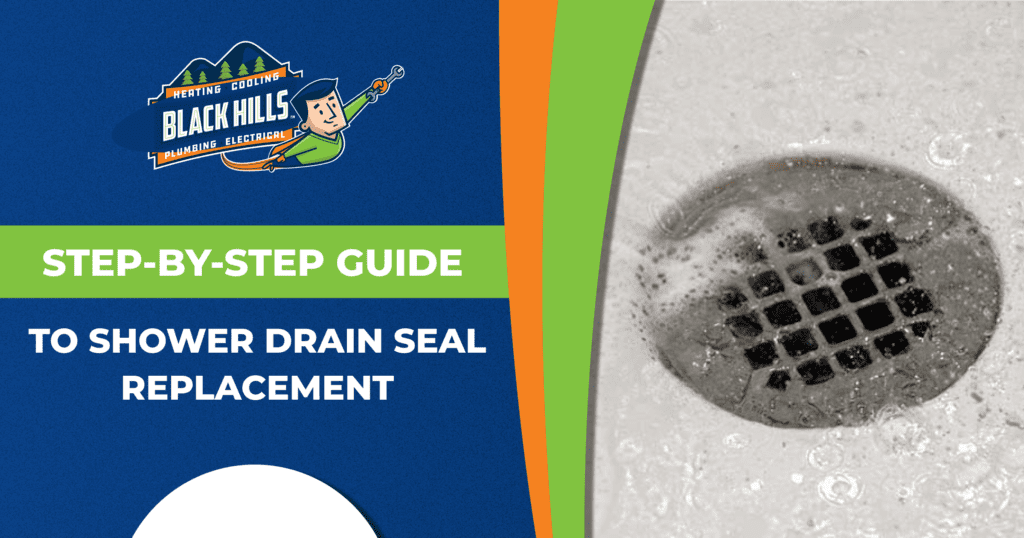A leaky shower drain isn’t just annoying – it can cause serious damage if left unrepaired. Water seeping through your bathroom floor can lead to rotted subfloors, damaged ceilings, and even dangerous mold growth. Fortunately, replacing or resealing a shower drain is typically a manageable DIY project. In this guide, we’ll show you how to reseal or replace your shower drain.
Time Required: 1-2 hours
Skill Level: Intermediate
Cost: $40-50 for materials
Supplies Needed
Tools:
- Flathead screwdriver
- Phillips screwdriver
- Putty knife
- Pliers
- Adjustable wrench
- Clean rags
- Flashlight
Materials:
- New shower drain assembly
- Plumber’s putty or silicone caulk
- Cleaning supplies
- Funnel (for testing)
Step-by-Step Drain Replacement Guide
1. Remove the Shower Drain
Start by removing the drain cover. Look for any visible screws that need to be removed first. Some covers will twist off counterclockwise, while others might need gentle prying with a flathead screwdriver.
Once the cover is off, thoroughly clean the area. Remove all old plumber’s putty or caulk from around the drain opening. Clean the surface thoroughly with soap and water, then allow the area to dry completely before proceeding.
2. Choose the Right Replacement Drain
The type of shower you have will determine the correct replacement drain. For a plastic or fiberglass shower base, consider using a top-mount compression drain. If you have a tile shower, you’ll need a traditional three-piece drain. Before purchasing a drain, measure your drain pipe diameter – most are either 2-inch or 1½-inch.
3. Install the New Drain
Begin by preparing the new drain. Apply a generous bead of plumber’s putty or silicone around the flange. If your drain comes with a rubber gasket, position it correctly. Make sure any anchors or threading are properly aligned before proceeding.
Next, carefully insert the drain into the drain hole. Press down firmly to create a good seal. Secure the drain according to the manufacturer’s specific instructions. Be sure to clean away any excess putty or caulk immediately before it sets.
4. Test the Installation
Start testing with a slow flow of water, then gradually increase the volume. Check for leaks from all angles, and observe both during and after water flow. Pay attention to the seal by looking for any water seepage around the edges. Verify that the water is draining properly and listen for any unusual sounds that might indicate problems.
Resealing a Shower Drain – Leaking Shower Drain Repair Guide
If your shower drain flange leaks, you’ll need to replace both the gasket and plumber’s putty to fix the problem. Follow these steps to create a watertight seal:
1. Remove the Drain Cover
Take off your shower drain’s pop-up stopper or lid. You might find a twist-off mechanism, hidden Phillips screw, or lug nut attachment. After removing the stopper, use a wrench to unscrew the connecting pin.
2. Access the Drain Flange
Grab a pop-up plug wrench and unscrew the drain flange. Carefully pull out the flange to check the gasket beneath it. This rubber gasket creates a seal between your shower’s drain hole and drain fitting. Replace any gasket that shows signs of damage.
3. Clean and Prepare the Drain
Remove all rust and grime from the shower drain body. A clean surface helps create a better seal. Set your new gasket in place and position the drain body back into the opening.
4. Seal with Plumber’s Putty
Apply a generous amount of plumber’s putty under the flange before reinstallation. As you screw the flange back into place, putty will squeeze out around the edges – this means you’re getting a good seal. Wipe away excess putty and give it time to set.
When to Call a Professional
Some drain replacements are best left to a licensed plumber. For example, if you have a specialized drainage system or suspect you have a leak elsewhere in your plumbing system, it’s best to call in a professional. Additionally, mold or structural problems require immediate professional help to protect your home.
Speak to an Experienced Plumber
When you need a professional plumber in Olympia, WA, turn to the experts at Black Hills. Our licensed plumbers can diagnose and repair any drain issue, ensuring your bathroom stays leak-free. Call (360) 822-9659 to schedule a plumbing inspection or fixture replacement service!
Drain Replacement FAQ
Can I Reuse My Old Drain Cover?
While it’s possible to use your old drain cover, replacing the entire assembly provides the best seal and prevents future leaks.
Should I Use Plumber’s Putty or Silicone?
Silicone creates a stronger seal but makes future replacement more difficult. Plumber’s putty offers easier access for future repairs.
How Often Should Drains Be Replaced?
Most shower drains last 15-20 years. Replace them sooner if you notice wear, corrosion, or leaks.
What Causes Shower Drains to Leak?
Shower drains typically leak due to worn seals, loose fittings, corrosion, or improper installation.

